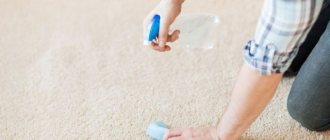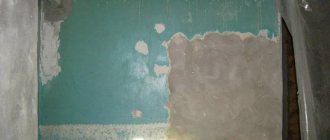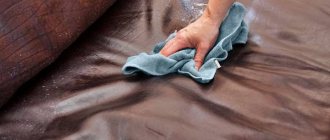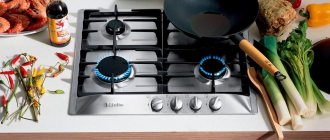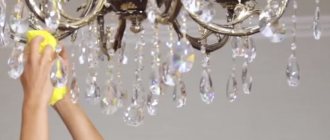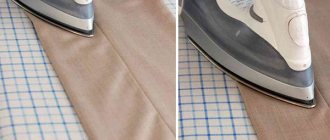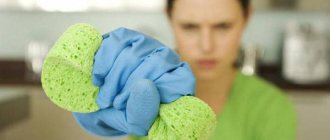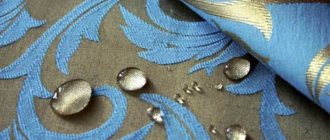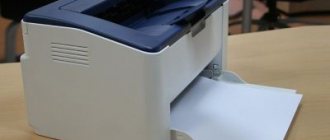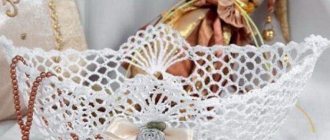To decorate the kitchen table, housewives are increasingly using products made from oilcloth, Teflon, vinyl, PVC and non-woven material. They look attractive, are easy to clean from dirt, and do not lose their properties for a long time, but sometimes it becomes necessary to smooth out a surface covered with creases. And this is where the problems begin, because you can’t get rid of aesthetic defects in the traditional way. But there are still approaches with which you can quickly restore the smoothness of the material.
Methods for smoothing oilcloth
With regular use, the oilcloth tablecloth does not wrinkle. But if it remains folded for some time, visible grooves will appear on its surface that are difficult to straighten. Neither sagging the product using weights nor placing it under heavy books will help here. Using an iron may cause burns.
It is better to try to soften the product in the following ways:
- Spread the oilcloth on a dense surface (large table or floor) and take a hairdryer. We set the medium mode using hot air; cold air will not help here. We direct the heat stream to the folds, holding the device at a distance of 25-30 cm from the surface of the material. Wrinkles will disappear before your eyes. You just don't need to bring the heat source closer to the surface or increase the temperature, this can lead to an accident.
Tip: To avoid having to deal with wrinkles on tablecloths made from thick raw materials, they should not be folded, but folded before storage. This will not only prevent wrinkles from appearing, but will also prevent chafing from forming.
- Soak the tablecloth in very warm, but not hot water, and press out the folds with your hands. We hang the product on a rope, securing it with clothespins (you don’t need to just throw the material on the frame - this will create additional hassle). We hook the load from below, distributing it evenly. The product will stretch and take the desired shape.
- If there are few folds, the item may not hang. We lay it out on a horizontal surface and press the problem areas with books.
As a last resort, we treat the rubber with an iron. We choose the most economical mode: “Silk” or “Synthetics”. To carry out the manipulation, we use a pad in the form of a dry or slightly damp cloth. There is no need to press hard on the device; we do not stand in one place for a long time.
How to work with other materials?
Vinyl and PVC products can be smoothed in the same way as regular oilcloth. The only thing is that you will have to make minor adjustments to the process, taking into account the density and characteristics of the materials. By the way, it’s a good idea to read the information on the product label; you can find a lot of useful information in it.
Non-woven materials usually do not tolerate washing and ironing well, so disposable tablecloths are made from them. They are disposed of immediately after use, so they cannot be expensive. Even long-term storage has a detrimental effect on them, so you should not keep products in the closet for too long.
Particular attention will have to be paid to the Teflon tablecloth. In general, this material does not wrinkle when washed correctly. If such a problem does occur, use a slightly warm iron. The work is carried out from the wrong side of the product; do not press too hard on the device so as not to damage the shape of the fabric. It is worth considering that with regular cleaning and ironing, Teflon loses its color. In order to expose it to aggressive influences as little as possible, the tablecloth should be covered with a transparent film during use.
Is it possible to iron a tablecloth with an iron?
You cannot iron oilcloth in the traditional way at normal temperatures. Getting rid of wrinkles is easy - you need to iron in the most gentle mode with the lowest possible heating temperature. The iron should be warm, but not hot.
The procedure is as follows:
- First, a piece of cotton fabric is placed on the surface of the rubber. To be sure, lightly moisten the rag with water and wring it out well.
- Set the iron to the softest built-in setting.
- The work is done from the reverse side of the canvas. Quickly loses its original shade when moving from the front.
- Swipe over the tablecloth several times. The manufacturer does not recommend staying in one place for more than one second. Do not use force or press on the iron; It's easy to ruin the coating.
- After smoothing, allow the fabric to cool slightly.
Ironing is dangerous for thin oilcloth fabrics. It's best to store them in a way that prevents them from seizing.
Is it possible to smooth out wrinkled oilcloth with steam?
Another way to get rid of aesthetic defects on a disposable tablecloth is long exposure to steam.
- Method one. The covering is kept over a pan of hot water. But boiling water will not work; it is too harmful for thin materials. The water should be around 50°C. Exposure to steam will cause the oilcloth to become damp. It is hung in a vertical position on clothespins, with medium-heavy weights attached to the lower edge.
- Method two. After exposure to steam from a container of heated water, the tablecloth is placed on a horizontal surface. Flat, heavy objects are placed in place of the creases. A stack of books, magazines, or a heavy box will do. After 2-3 hours, the wrinkles will smooth out.
The same methods can be carried out by replacing the steam pan with a steamer. After processing the oilcloth in a suspended position, leave it to dry or spread it on a smooth table.
How to iron an oilcloth tablecloth at home
To prevent unsightly folds on the oilcloth tablecloth, it should be stored in a roll, but this is not always convenient. Only a tablecloth purchased or stored folded for a long time will always have wrinkles in the fold. Having laid it out on the table, they will disappear, but after a while. This time depends on the type of product, its thickness and quality. If you don't have the time or desire to wait, you can use some leveling tips.
Alignment Methods
There are several ways to straighten an oilcloth tablecloth.
Alignment Methods
There are several ways to level an oilcloth tablecloth.
- When open, on a flat surface, use a regular hairdryer to go over the folds. The hairdryer must be kept at least 25 centimeters away from the surface, otherwise the product may be damaged. This technique is effective, but labor-intensive, especially if the area is large and there are many creases. Thick material will have to take longer to heat through the entire thickness.
- Soak the oilcloth in hot water, but not boiling water, and hang it by one side so that it smoothes out under its own weight. Or attach weights for weighting, but in this case the fabric may warp if you distribute the weight unevenly or choose too massive weights.
- Wet the tablecloth in hot water, as in the second point, and lay it out on the table, placing weighting objects in curved places. When using this method, keep in mind that marks may remain, so you should not keep them for long.
- Use the iron on minimum setting and with a damp cloth. Gently smooth out any unevenness using stroking movements.
Depending on the material from which the oilcloth is made, certain technologies work differently and have unequal effectiveness. Let's consider the types of materials separately.
Tablecloth made of polyester and PVC
Polyester is the most common and affordable material for kitchen tablecloths. It washes quickly and easily, does not fade, is inexpensive, and does not wrinkle much. They make all-polyester products and cotton-based polyester tablecloths.
Both options cannot be boiled, and ironing is not recommended even with minimal heat with an iron or hairdryer. Such materials melt under high temperatures, so straightening methods are best used without the use of these devices. Use heavy loads or objects.
Polyvinyl chloride is the second most popular material due to its practicality and durability. If wrinkles or unevenness occur, gently iron the PVC tablecloth using an iron on the lowest setting using light, smooth movements. Iron only with a damp cloth! For thin material it is convenient to use a hair dryer.
Products made of polyester and PVC do not like to be washed and are considered disposable. The material should be periodically cleaned with a damp sponge or cloth and then dried. Then the tablecloth will last a long time. But when it loses its attractive appearance, it is better to replace the product with a new one rather than resort to washing.
In rare cases, oilcloth can be washed, but only by hand and at a temperature not exceeding 40 degrees. These tablecloths are ideal for garden furniture on the terrace, in the bathhouse or in the country house.
Vinyl
This is a very practical and easy-to-use material, prevents slipping on the table and protects furniture from damage, and at the same time looks very aesthetically pleasing. There are models of oilcloths that imitate fabric. They do not need to be washed, they do not wrinkle when crumpled for a short time, but if there are large folds, then it will be enough to smooth them out with a warm iron through a damp kitchen napkin.
We recommend: 4 ways to clean hair from chewing gum without drastic measures
Please note that vinyl is sensitive to high temperatures, so before ironing, it is recommended to try it on an inconspicuous corner so as not to spoil everything. There is no need to press hard and stay at one point for a long time; just walk lightly, if necessary, several times.
What and how can you quickly smooth out an oilcloth, vinyl or Teflon tablecloth?
To decorate the kitchen table, housewives are increasingly using products made of rubber, Teflon, vinyl, PVC and non-woven material. They look attractive, are easy to clean from dirt, and do not lose their properties for a long time, but sometimes it is necessary to smooth out the surface covered with wrinkles. And this is where the problems begin, because aesthetic defects cannot be removed in the traditional way. But there are still approaches with which you can quickly restore the smoothness of the material.
Hot water
You can also wet the tablecloth with hot water. And here it is important to understand that hot water and boiling water are two different things. The optimal temperature is 60 degrees, the main thing is not to use boiling water.
Just pour hot water into the bath and put a tablecloth there for a few minutes. After this, the material must be hung on a rope, carefully securing it so that new creases do not appear. This method has proven itself, but it cannot always boast of its effectiveness.
How to Level a Vinyl Tablecloth
Vinyl oilcloth looks elegant and successfully imitates fabric. It is difficult to wrinkle during use, but the material tends to wrinkle even before the first use. To smooth it, use an iron and a cotton cloth soaked in water.
Vinyl siding does not withstand extreme heat; you should not use the iron at full power or stay in one place for a long time. This may damage the canvas.
Wet the lining with warm water and remove creases and wrinkles. Water is drawn into a spacious sink or bathtub and a tablecloth is lowered into it. The wet oilcloth is hung vertically and allowed to dry.
Polyvinyl chloride
PVC material is popular due to its long service life and practicality. Does not require ironing, but if such a need arises, use an iron and a damp cloth. Minimum temperature is required, all irregularities are removed with light, smooth movements. Using a hair dryer is acceptable, even more convenient, if the thickness is small.
Advice
PVC products can only be washed at water temperatures up to 40 degrees Celsius - and only by hand.
Polyester
The most common oilcloth in the kitchen, because it washes well, does not loosen, does not wrinkle, and is economical. Some are made of pure polyester and some are made of cotton. The first option is strictly forbidden to boil; it melts quickly and is afraid of fire. The second burns twice as fast and also does not tolerate boiling. Therefore, temperature straightening methods are used very carefully.
When getting wet and drying until smooth, you must avoid direct sunlight, as they can only damage the product. But overall the method is very suitable for this material.
Sources
- https://tekstil-doma.ru/stirka-glazhka/kak-vypryamit-kleenku.html
- https://HobbyLaby.ru/izdeliya/kak-razgladit-kleenchatuyu-skatert.html
- https://atmospherehome.ru/opyt/kak-razgladit-kleenku.html
- https://chelc.ru/mozhno-li-gladit-skatert-iz-pvkh
- https://mschistota.ru/sovety/razgladit-kleenchatuyu-skatert.html
- https://4textile.ru/stirka-glazhka/kak-razgladit-kleenku.html
- https://IsoProfTeh.ru/bytovaya-himiya/kak-razgladit-kleenku.html
- https://comfort-world.ru/na-zametku/kak-razgladit-kleenku.html
- https://CrystalSoap.ru/stiraem/kak-razgladit-kleenku-na-stole.html
- https://retro-dress.ru/domashnij-tekstil/kak-razgladit-kleenchatuyu-skatert.html
- https://PosudaIzKamnya.ru/produkty/kak-razgladit-skatert-iz-pvh.html
- https://costume55.ru/domashnij-tekstil/kak-vypryamit-kleenku-dlya-stola.html
- https://sitytreid.ru/plenka/kak-razgladit-polietilenovuyu-plenku.html
- https://bfpais.ru/kak-razgladit-skatert-iz-polivinilchlorida/
- https://tvoidomnn.ru/tehnika-dlya-byta/kak-razgladit-kleenku.html
Acrylic
This is a wear-resistant and waterproof material based on cotton or linen, but, unlike natural woven fabrics, it does not wrinkle and is not afraid of stains, while maintaining the structure and properties of ordinary fabric, creating a spectacular look on the table. Acrylic impregnation is resistant to high temperatures and can withstand a hot pot or frying pan. It can be washed and ironed on the reverse side at normal temperatures. There is no need to use other methods here.
There is only one drawback - over time, acrylic loses its properties.
Smooth silicone heat-resistant oilcloth
Great news! Unique new items have gone on sale that will be of interest to many: a transparent silicone tablecloth for tables and surfaces, which will replace your outdated and impractical textile tablecloths!
The smooth silicone oilcloth, known as flexible glass, fits tightly to the surface and prevents the ingress of debris and liquids. It is characterized by increased strength, does not deform from moisture, and reliably protects against scratches and stains. A smooth tablecloth looks good and is suitable for wooden, plastic, matte and textured tabletops.
Can be used not only for kitchen tables, but also for countertops, desks, gazebo tables, outdoor tables and veranda tables.
Features of flexible glass
• Perfectly smooth and crystal-transparent surface. • Practicality, resistance to dirt (almost any dirt can be washed quickly and without the use of special cleaning agents). • Resistance to acids, alkalis, salt solutions, alcohols. • Elasticity (the tablecloth lies flat on the table surface, does not bulge, does not “bubble”, but does not stretch). • Noiselessness (the tablecloth does not rustle or squeak when touched). • The material is non-toxic and odorless. • The material can withstand high and low temperatures. • The tablecloth does not slip or slide off the table. • Fits perfectly into any interior without changing its style.

